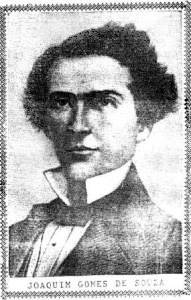Mathematical research in Brazil is much younger than in other parts of the world. Roughly speaking, one may say
that consistent activities, integrated with the international mathematical community, started only by the middle
of the 20th century. But a hundred years before, a young mathematician born in the northeastern province of
Maranhão, was able to breach the country’s relative isolation and have some part in the European mathematical scene.
The story of Joaquim Gomes de Souza is told in an
article (in Portuguese) by Dicezar Lass Fernandez (Unicamp)
which we sumarize in the text that follows. Professor Fernandez and collaborators are
currently working on a book on the life and work of Gomes de Souza.

Joaquim Gomes de Souza
Joaquim Gomes de Souza is generally considered to be the first Brazilian mathematician, as he was the first to
produce and publish mathematics in the country. His was a country whose first institutions of higher education
were just being created, following the coming of the Portuguese Royal Family to Rio de Janeiro in 1808, fleeing the armies of Napoleon.
Gomes de Souza was born in the province of Maranhão em 1829 and moved to Rio de Janeiro in 1843 to enroll in
one of these institutions, the Escola Militar da Corte (Royal Military School). The Escola Militar, founded in 1810,
was modelled on the École Polytechnique of Paris and offered a course in mathematics that included access to the
works of Euler, Bezout, Laplace, Monge and Legendre, among other mathematicians.
After only a year, Gomes de Souza took time out from the Escola Militar to enroll in the also newly created
Faculty of Medicine. A few years later, in 1847, he went back to the Escola Militar where he was granted the
right to take the remaining exams without attending classes. His brilliant performance in the exams earned him
the degree of B. Sc. in mathematics in 1848, at the age of 19. A few months later he got a doctoral degree with
a thesis based on the work of Laplace (theses were not required to contain original research) and he was subsequently
hired as a professor at the Escola Militar.
By 1854, seeking to free himself from the limitations of Brazil’s scientific scene, Gomes de Souza travelled to Paris,
where he was to reside for a few years. During this time, he attended several courses at the Sorbonne and established
contacts with French and British mathematicians. In 1855 and 1856, he wrote several mémoires to the French Academy of
Sciences. These works were submitted to the evaluation of a committee formed by Liouville, Lamé, Bienaymé and (later)
Cauchy. Alas, this committee never met and Gomes de Souza returned to Brazil in 1857, disappointed to have received
no report on his work. By then he had been elected a representative of Maranhão at the Assembleia Geral
(national Parliament) of Brazil and he quit mathematics for good. A few years later, already seriously ill, he returned
to Europe in search of medical treatment. Gomes de Souza died in Paris in 1863, at the age of 35.
The mathematical work of Gomes de Souza dealt with several problems in Analysis and its applications, introducing new
methods for the solution of differential and integral equations, as well as applications of these methods to problems in Physics.
Although it was never published in France, his work was taken over and extended by a second generation of Brazilian
mathematicians, that included Otto de Almeida Silva (1874 - 1912) and his student Manuel Amoroso Costa (1885-1928).
Thus, although little known and largely forgotten, the contributions of Gomes de Souza turned out to be consequential
in the context of the birth of a mathematical community in the country.
